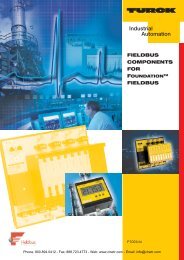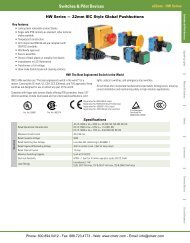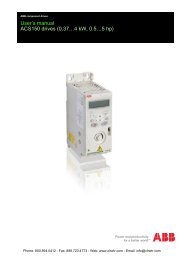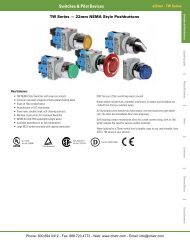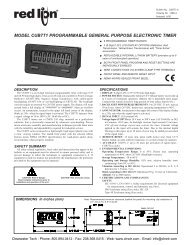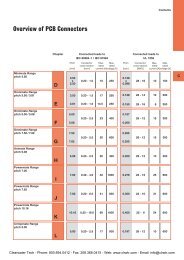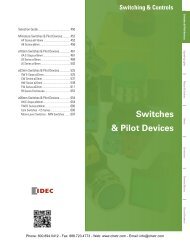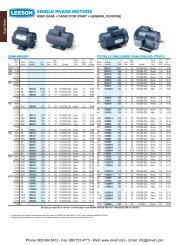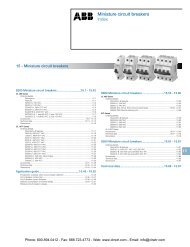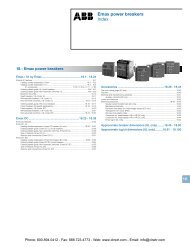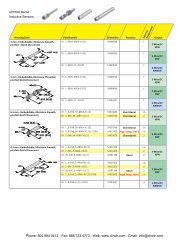IDEC / Datasensor Sensors - Clearwater Technologies, Inc.
IDEC / Datasensor Sensors - Clearwater Technologies, Inc.
IDEC / Datasensor Sensors - Clearwater Technologies, Inc.
You also want an ePaper? Increase the reach of your titles
YUMPU automatically turns print PDFs into web optimized ePapers that Google loves.
<strong>Sensors</strong><br />
General Information<br />
Glossary<br />
Attenuation: Reduction of beam intensity as a result of environmental factors<br />
such as dust, humidity, steam, etc.<br />
Dark on: Output energized when light is not detected by the receiving element.<br />
For through-beam sensors, light from the projector is not detected by the receiver<br />
when an object is present. For refl ected light sensors, light is not detected<br />
when it is not reflected from an object surface.<br />
Diffuse-reflected light sensors: <strong>Sensors</strong> that detect all scattered and refl<br />
ected light. Light reflected from nearby surfaces, as well as the intended object<br />
surface, is detected. Diffuse-refl ected light sensors are often called “proximity<br />
switches,” since they switch when any object is near. Also use to detect color<br />
contrast when colors reflect light intensity differently (green LED recommended<br />
for this application).<br />
EEPROM: Acronym which stands for electronically erasable, programmable,<br />
read only memory.<br />
Excess gain: Ratio of optical power available at a given projector-to-receiver<br />
range divided by the minimum optical power required to trigger the receiver.<br />
Extraneous light: <strong>Inc</strong>ident light received by a sensor, not related to the<br />
presence or absence of an object being detected. Extraneous light is usually<br />
unwanted background light such as sunlight and incandescent lamps in close<br />
proximity.<br />
ΔE: The measurement of color difference as a three-variable function, located on<br />
an XYZ axis of light, hue, and chroma values.<br />
Hysteresis: The lag in response shown by an object in reacting to changes in<br />
the forces affecting it . Operating point and release point at different levels. For<br />
solid state sensors, this is accomplished electrically. For mechanical switches, it<br />
results from storing potential energy before the transition occurs.<br />
Light on: Output energized when light is detected by the receiving element. For<br />
through-beam sensors, light from the projector is detected by the receiver when<br />
an object is not present. For refl ected light sensors, light is detected when it is<br />
refl ected from an objects surface.<br />
Linearity: The measure of the extent to which a certain response is directly<br />
proportional to the applied excitation.<br />
NPN/PNP: Types of open collector transistors. NPN is a sink transistor; output<br />
on establishes negative potential difference. PNP is a source transistor; output<br />
on establishes positive potential difference.<br />
Polarizing: Filtering out all refl ected light except that which is projected in one<br />
plane only. Polarized retro-refl ected light sensors detect the light from cornercube<br />
type reflectors when an object is not present.<br />
Reflected-light sensors: <strong>Sensors</strong> with the projector and receiver in one housing.<br />
Light is projected by the light source, and refl ected light is received by the<br />
optical surface. <strong>Inc</strong>ludes diffuse-refl ected, retro-refl ected, limited-refl ected, and<br />
spot-refl ected sensors.<br />
Repeatability: Ability of a sensor to reproduce output readings consistently<br />
when the same value is applied consecutively, in the same direction, for a specifi<br />
ed number of cycles, or for a specifi ed time duration.<br />
Resolution: Overall dimension of the smallest object which can be detected<br />
(when sensing the presence of an object) or smallest increment of distance<br />
which can be distinguished with reliable results (when sensing the position of<br />
an object).<br />
Response time: Time elapsed between input and output. Total response time is<br />
the sum of object detection, amplifi er response, and output response times.<br />
Retro-reflective: This type of refl ected light sensor uses a special reflector to<br />
return projected light when an object is not present. Sensor detects the presence<br />
of an object when the light is refl ected differently.<br />
Through-beam sensors: <strong>Sensors</strong> with a separate projector and receiver. The<br />
light source from the projector is detected by the receiver, except when an object<br />
is present.<br />
Transient: Undesirable surge of current (many times larger than normal current)<br />
for a very short period, such as during the start-up of an inductive motor.<br />
PLCs Operator Interfaces Automation Software Power Supplies <strong>Sensors</strong> Communication & Networking<br />
<strong>Clearwater</strong> Tech - Phone: 800.894.0412 - Fax: 208.368.0415 - Web: www.clrwtr.com - Email: info@clrwtr.com237




